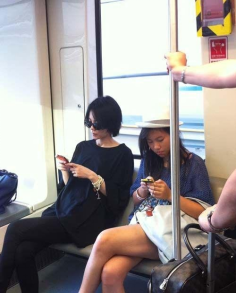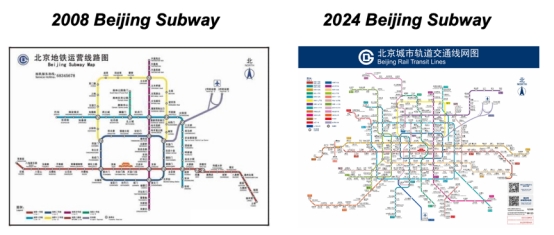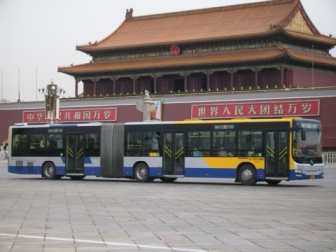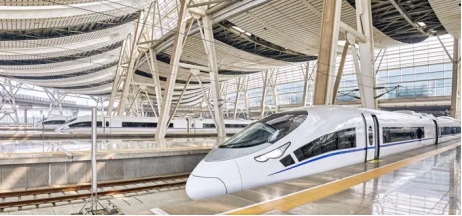Welcome to Beijing! I’m Chen.
For those tourists who visit Beijing for the first time, a key question is how to get around the city and which transportation is recommended for tourists. Today I would walk you through all the main transport options so that you could make a better and all-round decision.
First of all, I highly suggest you to install Amap on your phone because Google map and other mainstream navigation maps may not work in China, missing many key locations and having wrong information about public transportations. However, if you are an iPhone user or you got an iPhone user on your group, you’ll be fine. You could use the Apple map which is well maintained and operated in China.

Didi – China’s Uber – Most convenient choice for most travelers.
Didi, also known as China’s counterpart for Uber, provides services in almost all tier-1, tier-2 and tier-3 cities in China (basically covering all the places a foreign visitor might go to). All you need to do is to select the pick-up point on the map and input your destination, and you could see the estimated bills as well. Once confirmed, there will be a driver on the way to pick you up. In Beijing, Didi charges about 1.8 to 2 CNY per kilometer plus time bill of 0.5 CNY per minute. For instance, a one-way trip to Mutianyu Great Wall around 80km would be around 180 to 200 CNY (24-27 USD). A typical pick-up from airport to hotel would be around 100 to 150 CNY, depending on where your hotel is and when you take the ride. There would be cheaper options if you decide to pool for the car or select lower-class vehicles. You could also select a MPV which could carry 6 passengers at the same time, but the price could be doubled. It would be the most convenient transport for most. And just like Uber, you pay all the bills in the app.

You could also use Didi at the airport or train station. But since those places are generally “high demand zones”, during peak hours, you may need to wait up to 20 or 30 minutes to get a car. And there are generally designated pick-up points at those places. Or you could also wait in line for the taxi by meter instead of Didi at airports or railway stations. Show the Chinese names of the destinations and ask them to charge by meter. There could be a highway usage fee (around 10-15 CNY, 1-2 USD) depending on the route you choose. It is recommended to pay the bill by WeChat or Alipay. The price is similar to Didi, slightly higher. If you don’t want to take the time to wait, or you just prefer a more straightforward pick-up from the airport, you could also book the pick-up at trip.com. Trip.com is one of the largest online travelling platform owned by a Chinese company called Xiecheng. So you could trust the service it provide in China. The price might be 20 to 30% higher but with the flight information required, it could offer a more personal pick-up service.
Generally, I would suggest you to book airport transport in trip.com so you get better service and don’t have to wait, get off the plane and get in a car. While during day-time, Didi is a more flexible option.
And also, for some areas, Didi could also be very difficult to get a car and even if you get one you may have to wait for a very long time for it to get to pick you up, such as the Sanlitun area, where is generally considered as Beijing’s night pub zone or Guomao area which is the CBD. So get prepared for that. But generally it would be fine.
Subway – Most reliable and Affordable for most travelers.
Subway may be the most reliable transport for Beijingners, as you would never be late as long as you set out at the right time (while traffic jam could literally turn Beijing’s roads into parking lot). A very famous singer (Faye Wong) used to go to her own concerts by subway to avoid traffic jams (as shown in the picture below).

You’d better not to keep your audience waiting, right?
Beijing’s subway is growing rapidly in recent years. Almost every year since 2008, we had at least 2 or even 3 new subway lines open in the same year.

And the Beijing subway is also very affordable. It is charged by the distance between the entrance station and exit station of your route. A one-way trip could cost between 3 CNY to 8 CNY (0.4 USD to 1 USD). Children under 1.3 meters tall are ticket-free if accompanied by one adult. Children between 1.3 meters and 1.5 meters could enjoy half-price but you may need to ask the staff to help you register for it.
You could buy a ticket on the automatic vending machines or at the manual window. The subway gates also accept quick tap payment of visa, mastercard and unionpay. You could also buy a public transportation card for frequent usage or set one up in your iPhone in the Apple wallet (for more details https://support.apple.com/en-sg/118272). The most convenient way would be to apply for a QR code in your Alipay and scan the QR code at the entrance gate and exit gate.
Most subway lines are open at around 5 to 6 in the morning, and close around 11pm to midnight. However that timing table is depending on the specific subway line you choose so you might need to look it up in the map apps.
The greatest part of subway is that you don’t have to worry about traffic jams and for most popular tourist sites like Tiananmen Square, the Forbidden City, Temple of Heaven, Beijing hutong and summer palace, there is at least one subway station nearby. However, depending on where your hotel is, it could also take longer time than Didi or taxi. And it could be somewhat crowded if it’s at rush hours. My recommendation is that if you’re a solo traveler or couple travelers and you have the full power to plan for your itinerary which doesn’t require you to be hurry a lot and you want to explore the city not only the tourist sites but also shopping areas, walking streets, fun areas, subway could be a very good choice. If you come in a group of 3 or 4 or even more, it could help justify the cost of Didi or taxi since more people on the group, fewer costs per person.
Bus – Large public transportation network connecting everywhere
Beijing has a very well-developed bus system. There’re over 1500 regular bus lines operating every day in Beijing. Most routes are operating from 5AM to 11PM. And generally it only costs you 2 to 3 CNY per ride, that is 30 to 40 cents in USD. All bus in Beijing don’t have conductors to sell tickets any more. So you may have to prepare the changes by yourself. Get some 1-CNY paper notes ready or get some coins. However, similar to the subway situation, I recommend you to set up your Alipay beforehand so you could scan the QR code to take a bus ride. Remember you also need to scan the QR code when get off the bus so you wouldn’t be charged by the highest possible cost. However, given the cheap price it charges, it won’t do any significant harm to your wallet. So rest assured if you miss doing that.

The biggest con of bus transportation despite of its affordability could be the complicated routes of travelling around the city, which really depends on the navigation app you use. So download A-map which is a very popular navigation app in China. It gives the best route of bus and subway transportation and it also gives you an estimated time of the route. It would also give you information about the operating time of a bus or subway and the estimated arrival time of the next bus when it’s available. Very useful app during your trip to China. Apple Map for iPhone users could basically nail the job as well.
Railway (Bullet Trains) – Quick Access to Badaling Great Wall and other Chinese cities
Some might be surprised that I mentioned railway in terms of inner-city transportation. Yeah, Beijing is a large city and sometimes for some routes you could even ride a bullet train to get around the city. We have bullet trains from Daxing airport to Beijing Xi Railway Station also known as Beijing West Railway Station. For those who want to visit Badaling Great wall, the bullet train is probably the most convenient and efficient way to get there. The bullet trains heading to Badaling depart at 2 stations in Beijing, one is Beijing Bei also known as Beijing North Railway Station, the other is Qinghe Railway Station, both have access to subway. A one-way ticket per person is around 20 CNY (3 USD) for a 20-min ride. You could get your tickets on 12306.cn which is the only official website for railway tickets. You may also get tickets on trip.com but that’s not official website and it’s likely you will be charged for an extra service fee. But that depends on you. If you want to save some trouble, I guess you might have to pay some extra.

By the way, for those who want to visit Mutianyu Great Wall instead of Badaling, forget about trains, Didi might be the better choice.
Also the bullet trains could be served as the perfect choice for inter-city transportation for cities within 1000 km away from Beijing such as Xi’an, Pingyao, Taiyuan, Inner Mongolia and so on. Because for those cities, it only took 4-5 hours on a high-speed bullet train and you could actually save more time comparing it to the airport (security check, luggage check-in, waiting for a shuttle bus, flight delays etc).
And also for those who want to save more time during the journey by sleeping on a train, yeah, we have sleeper berth options. I’m a light sleeper. So I generally don’t do that unless there is no other tickets left. Remember for sleeper berth, choose those trains with a train number starts at G or D since these are generally better classes. So sleeper berth, save time when you sleep and arrive in the morning also save the cost of a hotel and experience a train night. Can be a good choice for some. To book that, still, remember the official website, 12306.cn.
Tips: Airport and Subway Transportation
I feel like it could be the most exciting and also clueless time when you just get off an airplane and come to a new nation. So I feel like to fill you in with more information about transportation around airports. Like we’ve mentioned, you could book airport pick-up and drop-off on trip.com or just use Didi or call a cab. And you could also use airport express line. Beijing currently have 2 airports, one is Beijing Capital which is closer to the city and the other is Daxing Airport, the new one and larger one but remoter one. However both are have their airport express subway lines. It took about half an hour to get you from the airport to a major subway station in the city. Both are open at around 6 am to 11pm, the specific timing has some small differences depending on the terminals and dates. And the ticket price is around 25 to 35 CNY about 4-5 USD. There are also airport buses for those 2 airports. The ticket price is also around 30 to 50 depending on the time and route. However the destination of the airport bus is not likely where your hotel is. So you may still need to use Didi or take a bus or subway to get to the hotel. And that’s why personally I prefer airport express subway line to the airport bus upon arrival. Because it’s easier to get transfer.
To sum up, if you travel by yourself, the airport express subway line may be a better choice. If your arrival time is out of the service hours of public transportation, you could always use a Didi or wait for the taxi at the airport.
And the distance between the airport and your hotel is also a very factor taken into consideration. Generally, a Didi or taxi trip would cost you around 100 to 200 CNY and a single ticket of the airport express or airport bus could be 40 to 50 CNY. So, let’s do the math here, if you have 2 or 3 or 4 persons on the group, the total cost of transportation could be just the same as, or slightly higher than the public transportation (so…we have a winner?).
All in all, Beijing provides a very great transportation infrastructure, and you would have plenty of choices to get around the city and I’m pretty sure you could find one that suits you most.
Wish you a very happy journey in China! See you.